Better coverage, shorter cycle time, excellent match to OEM colors – the benefits of water-based paint systems go far beyond helping improve air quality.
It’s been seventeen years since the U.S. EPA set strict limits on the amount of volatile organic compounds (VOCs) allowed in automotive coatings, and water-based paints have come a long way. Not only is water-based paint a proven performer in color match and panel blending, it is now accepted by collision repair facility operators as more cost-effective than solvent-borne coatings. Water-based paint saves labor time, energy costs, and materials expense. High-volume shops point to an increased number of paint jobs and repairs completed per week, but even small shops appreciate the faster throughput, which translates to both higher profit margins and the ability to put customers back into their vehicles sooner.
Pretty Green
VOCs contribute to ground-level ozone, a major component of the smog in high car-count cities. We reduce the VOC content of paints because it is harmful to our lungs and immune system.
Waterborne paints have come down from approximately 75 percent solvent in conventional basecoats to only 10 percent solvent in waterborne basecoats, and have reduced solvent by up to 60 percent in clearcoats. That’s pretty green.
Yes, We Can
BMW became the first OEM to use waterborne paints in the U.S when, in 2010, we began using the technology in our factory in Spartanburg, South Carolina. Independent collision shops are more vulnerable to local weather conditions than climate-controlled factories, and don’t have factory-like robotics technology. And because they typically paint only a part of the vehicle body, they face color match challenges that the factory doesn’t have.
So the question arises, can aftermarket collision repair facilities achieve similar waterborne cost reduction benefits as big factories while maintaining excellent color match?
With BMW-approved Glasurit 90 Line, the answer is emphatically yes. 90 Line is a water-based paint system that provides a factory-like finish with greater coverage per coat than with conventional solvent, shorter drying times, excellent color match, high gloss, and UV protection for durability.
Better Coverage
Waterborne basecoats contain 20 percent pigment in their metallic or pearlescent formulations, one-third more than the 15 percent pigment content in solvent-borne basecoats. Having one-third more of the solids that remain after solvent evaporates means that, with water-based paints, you get the same coverage while spraying less paint. Using 90 Line basecoat, you’ll mix less, spray less, and save material cost and labor.
One basecoat spray may not give full coverage. Your objective is just to get an even, wet coat and a good blend-in. Here’s where skill matters. If you spray a coat and get good coverage, but weren’t careful enough to get a good blend, an additional make-up coat is going to eat up any cost savings you could have booked. So careful planning and execution are essential to achieving excellent color match the first time.

Use tape and masking paper that is water resistant. If waterborne paint soaks through the tape or paper, it will adhere to vehicle surfaces underneath.
Shorter Cycle Time
With the proper air flow, water evaporates faster than solvent, so you get shorter flash times. Faster flashover and better coverage leads to shorter cycle time and more throughput.
Excellent Color Match
The vast majority of new cars sold in the U.S. are now painted using water-based products. That gives body shops using water-based paint systems the ability to achieve precise color match to OEM finishes.
Its uniform evaporation rate means that water-based paint dries at a more even pace than solvent-based paint. This helps metallic pigments to all flop to almost the same angle in the film, resulting in a relatively uniform color reflection. When painters praise water-based paint’s “better control of metallics†to match the existing vehicle color, it is thanks to this even evaporation rate throughout the film. Simply spray the film thickness recommended by the paint manufacturer.
Additionally the pigments in water-based paints are half the thickness of solvent-borne pigments. Think of water-based and solvent pigments as two pots of marbles. Because there are more, smaller marbles in the water-based pot, they are packed closer together than those in the solvent pot. This more densely packed film offers greater opacity, which allows coverage with fewer coats. You can spray your first basecoat medium wet, then spray additional light coats, achieving blend-in using fewer coats than with solvent-based paint.
Water-based paints, when dry, are cleaner and brighter than their equivalent solvent-borne products. The OEM color formula matching, uniform evaporation rate for better flop control, greater opacity for thinner and fewer coats, and cleaner, brighter final appearance together all help make water-based paint easier to blend without halo effects, mottling or color shifts.

Unlike a solvent resin which, if clumped together, will re-dissolve in the presence of more solvent, a clump of waterborne paint that has dried will not re-dissolve. Make sure to filter your paint after mixing, in addition to any mesh filtration that is built into your gun.
Water-based paint has a different color appearance when wet than after drying. Even experienced painters can’t match water-based colors by eye when wet. You must prepare a spray out card, including basecoat and clear, and check it against the vehicle to ensure a match before you begin painting.
You’ll mix toners by weight, not volume, and computer software tells you the exact amount to add. If you overpour a toner, the software will adjust the other color components to re-balance the formula. It’s a lot like your GPS when the voice says “Recalculating,†and then tells you how to recover from your errant driving choices.
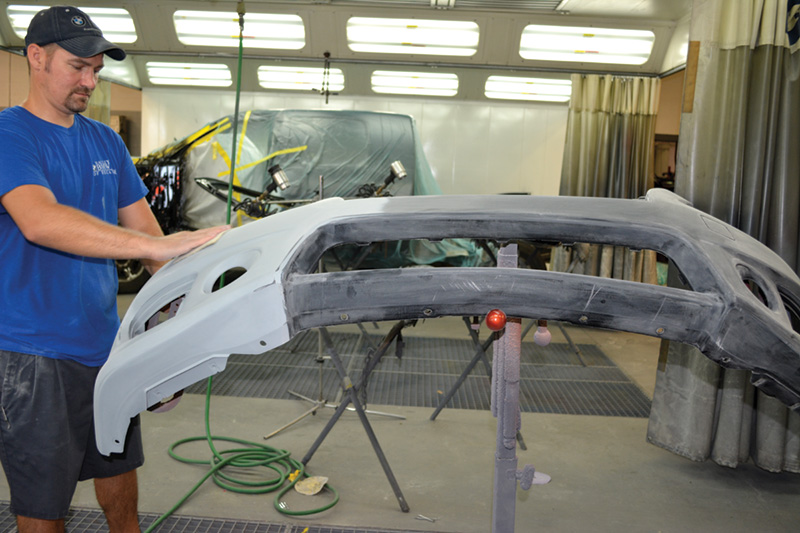
Because waterborne is a thinner paint film than solvent products, it tends to lay down in cracks or any other flaws in the surface, changing the light refraction. Sanding with a finer grit – 800 or finer – is critical to getting the surface smoothness needed for painting.
Smooth as a Baby’s Bottom
Water-based coatings are thinner than solvent-based paints. They settle into sanding scratches rather than smoothing over them as solvents did. Paint angled into the scratch grooves will reflect light differently than the surrounding coating, making the scratches stand out. It will take more than one extra coat to level out scratches, making that not very cost-effective. The paint manufacturer’s tech data sheets will likely recommend instead that you prep surfaces for water-based base coat by using a finer sanding grit than you would with solvent-based paints.
A related advantage is that you won’t worry about whether or not you can re-coat over a repair substrate. The absence of solvent means water-based coatings don’t cause the sanded edges of a repair to swell or deform.
Got Air Flow?
To dry waterborne coatings evenly and efficiently, you have to create air turbulence to ensure that air flow reaches all sprayed surfaces.
You’ll use the same laminar (downdraft) air flow at 120 – 400 fpm as occurred during spraying, and add horizontal air flow at 200 – 600 fpm. Check your 90 Line documentation for cfm recommendations for the specific paint you are using.
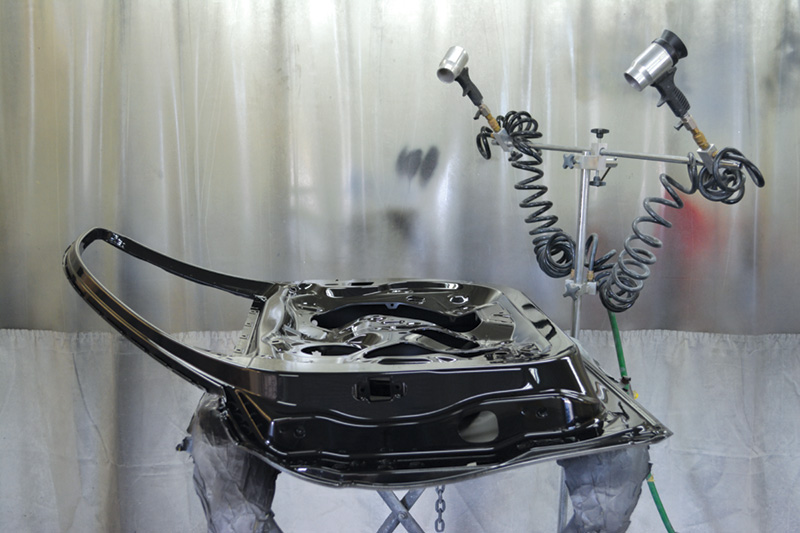
Portable air blowers are great for drying small areas, and for helping create horizontal air flow in the booth to create the turbulence that can speed overall drying.
The combination of two flow directions creates crosswinds, or turbulence, that breaks the envelope of air formed around the vehicle by the laminar air, and results in increased evaporation. It also helps speed drying of side panels, which otherwise can take longer than horizontal surfaces to reach the proper temperature for maximum evaporation. With proper air flow turbulence setup, painters routinely experience a 20 to 30 percent faster drying time.
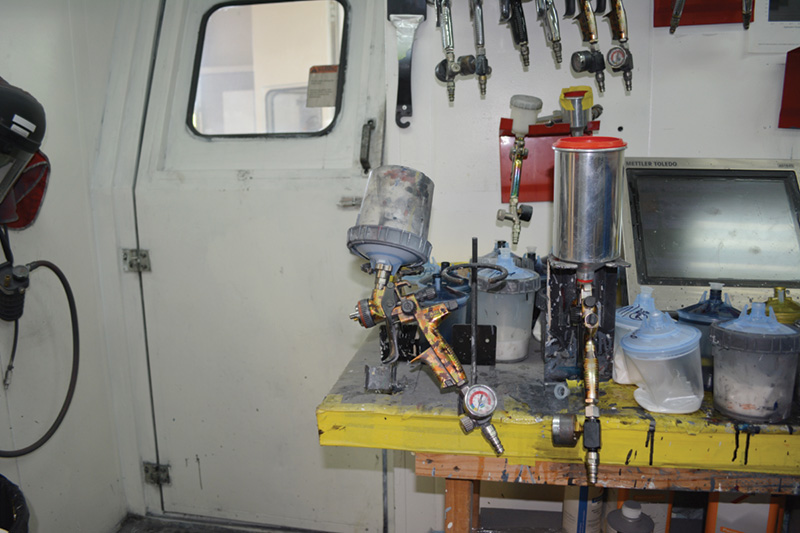
Use separate guns for waterborne base coat versus clear coat. Each requires a different nozzle size to accommodate the differing viscosities of clear versus base coat.
The 90 Line paint guidelines offer recommendations on viscosity, gun distance from the surface, nozzle/fluid tip size, pressure settings, spray overlap, and how soon after spraying to start using extra air flow to flash the paint. Study the 90 Line guidelines, pick the recommendations that best match ambient temperature and humidity conditions in your booth, and follow them closely.
Durable Finish
As they dry, the latex particles bind together chemically, and that gives water-based paint a superior chip resistance and durability.
Waterborne Spray Adjustments for Temperature and Humidity |
|||
|
Ambient Conditions |
High Temp and |
High Temp and |
High Temp and Low Humidity (100°+ / =30% R.H.) |
|
Result |
Dries Too Slowly |
Dries Faster than Desired |
Dries Extremely Fast |
Possible Spray Adjustments |
|||
|
Material per coat |
Apply less material |
Apply more material |
Apply more material |
|
Air pressure |
Increase pressure |
Decrease pressure – for |
Decrease pressure – for larger/wetter particles |
|
Gun distance / overlap |
Increase gun distance / less overlap |
Decrease gun distance |
Decrease gun distance |
|
Fluid tip size |
Consider slightly |
Consider slightly larger |
Change to larger |
|
Viscosity |
Lower viscosity |
Higher viscosity |
Higher viscosity |


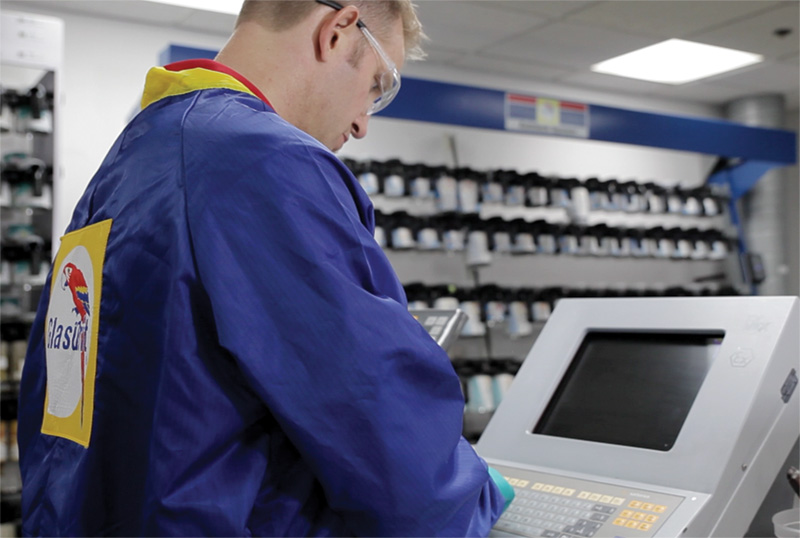
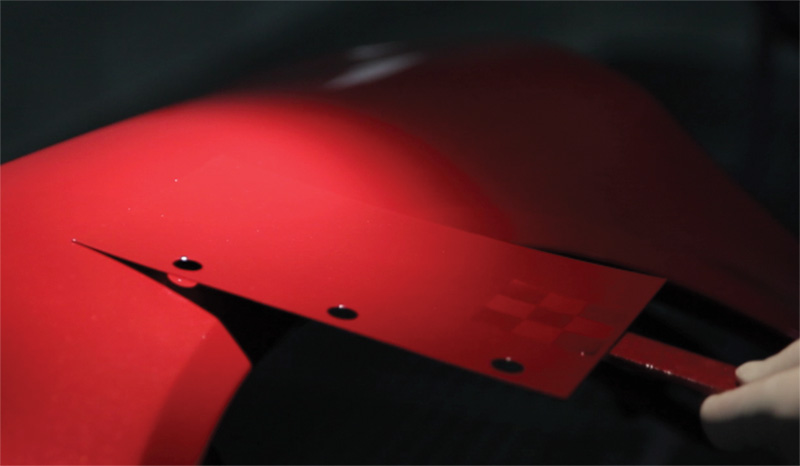



0 Comments